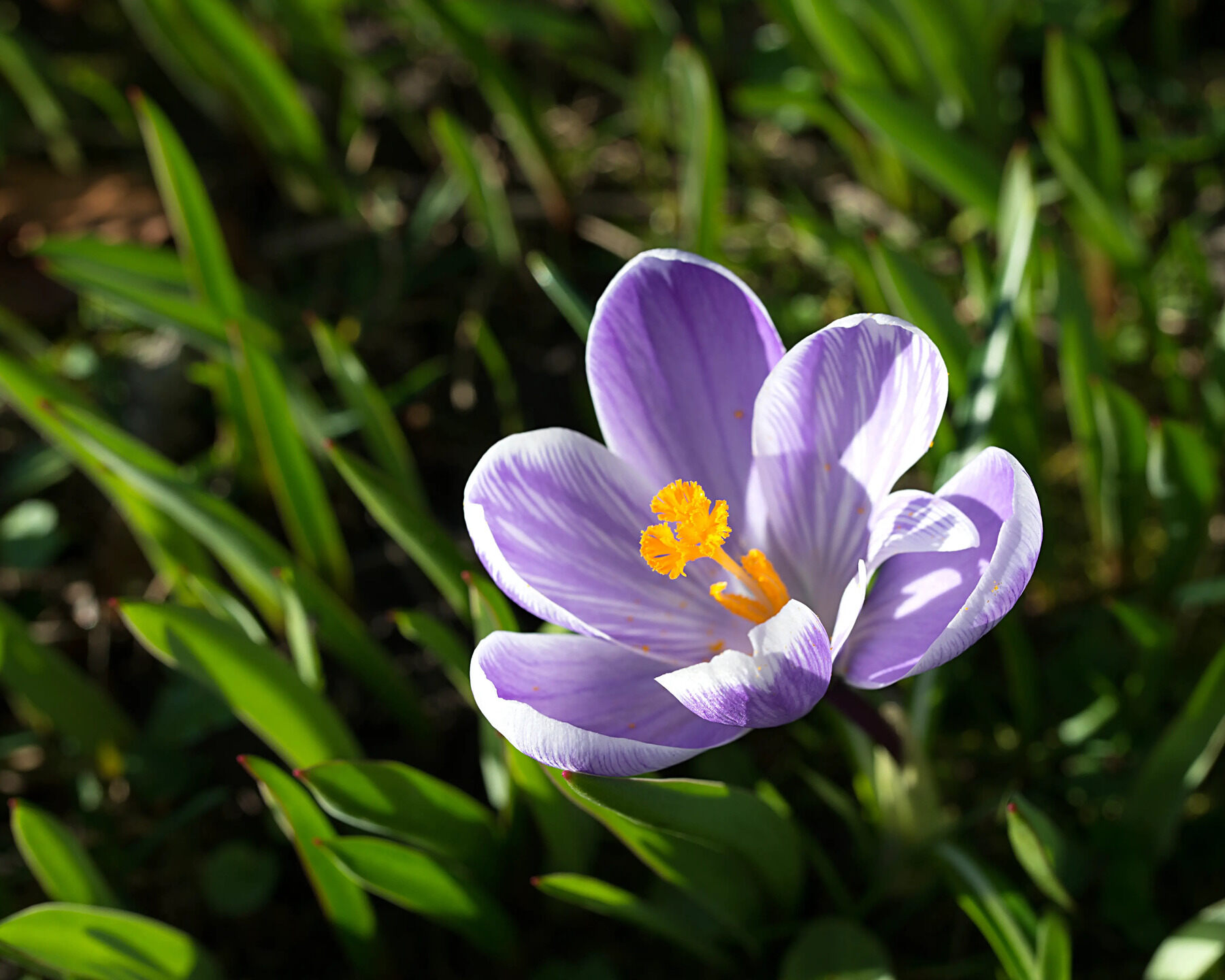
Crocus is a fascinating flower that captivates with its vibrant colors and delicate petals. These small, yet resilient plants belong to the Iris family and are native to Europe, North Africa, and Asia. They are known for their early bloom, often emerging from the cold, dormant ground when winter is still lingering. Crocus flowers have been cultivated for centuries, adding a touch of beauty to gardens and landscapes worldwide.
But there’s much more to crocuses than meets the eye. In this article, we will delve into 15 intriguing facts about crocus that will deepen your understanding and appreciation for these remarkable plants. From their rich cultural symbolism to their remarkable survival techniques, crocuses have a story to tell. So, let’s explore the world of crocus and uncover some fascinating secrets about these enchanting flowers.
Key Takeaways:
- The crocus flower symbolizes hope and renewal, blooming in vibrant colors and surviving harsh conditions. It’s edible, medicinal, and even produces the valuable saffron spice, making it a fascinating and versatile plant.
- Crocus flowers, members of the iris family, bloom early in spring, attracting pollinators and used in traditional dyeing. Their resilience and wide range of colors make them a favorite in gardens and parks, bringing joy year after year.
The Crocus is a Symbol of Hope and Renewal
The crocus is often associated with the arrival of spring and symbolizes hope and renewal. Its vibrant colors and delicate petals are a welcome sight after the long, cold winter months.
Crocus Flowers are Members of the Iris Family
Belonging to the iris family, the crocus is a genus of flowering plants that includes approximately 90 different species. These plants are known for their stunning colors and ability to thrive in various climates.
The Name “Crocus” has Ancient Origins
The word “crocus” originates from the Greek word “krokos,” which also referred to the saffron spice. This name was given due to the similar color of the crocus flowers and the saffron threads.
Crocus Flowers are Edible
Did you know that crocus flowers are not only beautiful but also edible? Some varieties of crocus flowers are used in cooking and baking, adding a unique flavor and vibrant touch to dishes.
Crocus Flowers Bloom in Various Colors
Crocus flowers come in a wide range of colors, including shades of purple, yellow, white, and even striped varieties. These colorful blooms make them a popular choice in gardens and floral arrangements.
Crocus Sativus Produces Saffron
One of the most well-known species of crocus is the Crocus sativus, which produces the valuable spice known as saffron. This spice is harvested from the stigmas of the flower and is highly prized for its culinary and medicinal uses.
Crocus Flowers Are Early Bloomers
Crocus flowers are among the first to bloom in the spring, often appearing even before the snow has completely melted. They are a delightful sign that warmer days are on the way.
The Crocus Is Native to Many Parts of Europe and Asia
Crocus flowers are native to a wide range of regions, including Europe, North Africa, and Asia. They can be found growing in various habitats, from meadows and woodlands to rocky slopes and alpine areas.
Crocus Flowers Have Medicinal Properties
In traditional medicine, certain species of crocus have been used for their medicinal properties. They are believed to have anti-inflammatory, antibacterial, and antioxidant effects and have been used to treat various ailments.
The Crocus Is a Hardy Plant
Crocus flowers are remarkably resilient and can withstand harsh weather conditions, including cold temperatures and frosts. They can also tolerate a variety of soil types, making them adaptable and easy to grow.
Saffron Harvesting Is a Labor-Intensive Process
The harvest of saffron, derived from the Crocus sativus plant, is a labor-intensive task. Each flower contains only three delicate stigmas, which must be carefully handpicked and dried to obtain the valuable saffron threads.
Crocus Flowers Attract Pollinators
The bright colors and sweet fragrance of crocus flowers attract various pollinators, including bees and butterflies. These insects play a crucial role in the pollination process and contribute to the reproduction of the plants.
The Crocus Is a Resilient Bulb Plant
Crocus bulbs have a unique property known as geophytes, which enables them to survive adverse conditions by going dormant underground. This resilience allows the plants to rebound and bloom year after year.
Crocus Flowers Are Used in Traditional Dyeing
For centuries, crocus flowers have been used to create natural dyes. The pigments extracted from these flowers have been employed to color textiles, giving them a beautiful and unique hue.
Crocus Vernus Is a Popular Garden Variety
Crocus vernus, also known as the Dutch crocus, is a popular variety often found in gardens and parks. Its large, showy flowers and early bloom time make it a favorite among gardeners.
In conclusion, the crocus is a fascinating and versatile flower with a rich history and numerous intriguing qualities. From its early bloom time and vibrant colors to its culinary uses and medicinal properties, the crocus holds a special place in our hearts and gardens. Whether enjoyed in the wild or cultivated in our own landscapes, these flowers continue to bring beauty and joy year after year.
Conclusion
In conclusion, crocus plants are truly fascinating and unique. Their vibrant colors, early blooming, and ability to thrive in diverse environments make them a favorite among gardeners and plant enthusiasts. From their historical significance to their medicinal uses, crocus plants have a rich and diverse background that is worth exploring. Whether you plant them in your garden or simply admire their beauty, crocus plants are sure to add a touch of elegance and charm to any space. So the next time you spot these delicate flowers, take a moment to appreciate the wonder of the crocus and all it has to offer.
FAQs
Q: How long does it take for crocus flowers to bloom?
A: Crocus flowers typically bloom within 3 to 4 weeks after planting, depending on the variety and environmental conditions.Q: Are crocus plants poisonous?
A: While crocus plants are generally safe, certain species contain alkaloids that can be toxic if ingested in large quantities. It is advisable to keep pets and children away from these plants.Q: Can crocus plants tolerate cold weather?
A: Yes, crocus plants are known for their ability to thrive in cold climates. They are often the first flowers to bloom in the spring, even when there is still snow on the ground.Q: Do crocus flowers come in different colors?
A: Yes, crocus flowers come in a variety of colors including purple, white, yellow, and even bi-colors. Each color adds its own unique beauty to the garden.Q: Can crocus plants be grown indoors?
A: Yes, crocus plants can be grown indoors in pots or containers. However, they require a period of dormancy and a cool period of around 6-8 weeks at temperatures of 35-45°F (2-7°C) in order to bloom successfully.Q: Are crocus flowers fragrant?
A: Some species of crocus flowers have a light, sweet fragrance. However, not all varieties have a noticeable scent.Q: Are crocus flowers attractive to pollinators?
A: Yes, crocus flowers are an important source of nectar for early pollinators like bees and butterflies. They help provide essential nutrition at a time when food sources are scarce.Q: Are crocus plants easy to grow?
A: Yes, crocus plants are relatively easy to grow, making them suitable for both beginner and experienced gardeners. They require well-drained soil and full sun or light shade.Q: Can crocus plants be divided and propagated?
A: Yes, crocus plants can be divided and propagated by separating the corms (bulb-like structures) after the foliage has died back. This can be done in late summer or early autumn.Q: Are crocus plants deer-resistant?
A: Yes, crocus plants are generally deer-resistant. Their bitter taste and toxicity make them unappealing to deer and other herbivores.
Was this page helpful?
Our commitment to delivering trustworthy and engaging content is at the heart of what we do. Each fact on our site is contributed by real users like you, bringing a wealth of diverse insights and information. To ensure the highest standards of accuracy and reliability, our dedicated editors meticulously review each submission. This process guarantees that the facts we share are not only fascinating but also credible. Trust in our commitment to quality and authenticity as you explore and learn with us.


